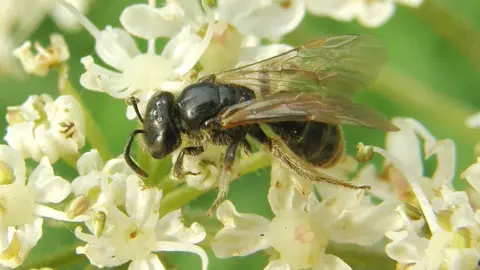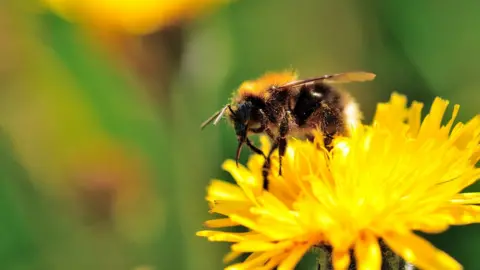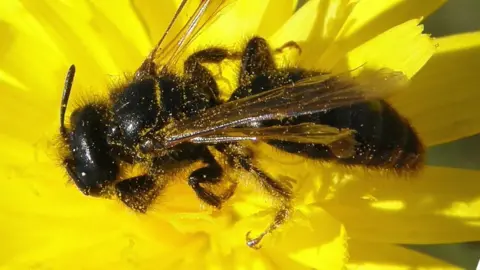Bees: Many British pollinating insects in decline, study shows
 Steven Falk
Steven FalkA third of British wild bees and hoverflies are in decline, according to a new study.
If current trends continue, some species will be lost from Britain altogether, the scientists say.
The study found "winners" and "losers" among hundreds of wild bees and hoverflies, which pollinate food crops and other plants.
Common species are winning out at the expense of rarer ones, with an overall picture of biodiversity being lost.
Scientists warn that the loss of nature could create problems in years to come, including the ability to grow food crops.
 Steven Falk
Steven Falk Lucy Hulmes
Lucy HulmesThe study looked at trends in 353 wild bees and hoverflies in Scotland, England and Wales over 33 years from 1980.
A third of species experienced declines in terms of areas where they were found, while about 10% became more abundant, including bees that pollinate flowering crops, such as oil seed rape.
While some pollination is carried out by honeybees in hives, much of the pollination of food crops and wild plants is carried out by their wild relatives and other insects, especially hoverflies.
Dr Gary Powney of the Centre for Ecology and Hydrology (CEH) in Wallingford, Oxfordshire, said while the increase in key crop pollinators is "good news", species have declined overall.
"It would be risky to rely on this group to support the long-term food security for our country," he said.
"If anything happens to them in the future, there will be fewer other species to step up and fulfil the essential role of crop pollination."


The losses were concentrated among the rarer, specialised species. Dr Nick Isaac, also of the Centre for Ecology and Hydrology (CEH) in Wallingford, Oxfordshire, said this was "particularly bad news if you're interested in wildlife and in conservation".
The "losers" include solitary bees, which live in burrows in the ground, and upland bees, living on mountains and moorlands. Among the "winners" are 22 of the most important crop pollinators.
 Mike Edwards
Mike Edwards Steven Falk
Steven FalkExperts say the increase in some common species is set against a background of an overall loss of diversity.
"Every square kilometre in the UK has lost an average of 11 species of bee and hoverfly, between 1980 and 2013, according to the new analysis," said Dr Lynn Dicks of the University of East Anglia.
She said the pattern of biodiversity loss is happening everywhere we look.
"It's a process of homogenisation and leaves us with a natural world that is far poorer and less resilient to change."
More stories like this:
Matt Shardlow, chief executive of the charity Buglife, said the new paper provides further evidence that our pollinators are in trouble and that the health of our environment and food supply cannot be taken for granted.
"Solitary bees, rare bees and bees and hoverflies that live in the uplands are in particular trouble and need urgent help," he said.
The research is based on analysis of more than 700,000 records from volunteers recording the presence or absence of insects in their area.
This gives a measure of whether the ranges of insect pollinators are getting smaller or larger, however it does not look at drivers for this change.
What's causing the decline?
The scientists think habitat loss is likely key. Other possible factors include climate change - which could be having an impact on upland and northern species.
They say the relative success of some species could be due to environmental measures put in place by farmers, such as sowing wildflower strips.
Or this might be because much more oilseed rape is grown now than in 1980.
Another factor is the use of insecticides. The scientists said it remained to be seen how pollinators might have been affected by restrictions introduced since the study was carried out.
In 2013, the European Union introduced a temporary ban on the widespread use of insecticides known as neonicotinoids in light of evidence suggesting they harmed bees.
Last year, the ban on three of the main neonicotinoid types was made permanent, and was widened to cover all crops grown outdoors.
What can be done to help?
The researchers say actions such as wildlife-friendly farming and gardening can have a positive impact on pollinators in both towns and the countryside.
They echoed previous calls for gardeners to encourage pollinating insects by growing patches of wild plants and weeds.
The loss of insects has far-reaching consequences for entire ecosystems. Insects provide a food source for many birds, amphibians, bats and reptiles, while plants rely on insects for pollination.
A recent scientific review of insect numbers around the world suggested that 40% of species were undergoing "dramatic rates of decline", with bees, ants and beetles disappearing eight times faster than mammals, birds or reptiles.
Previous studies have found losses of butterflies, moths, beetles, bees and hoverflies across the UK.
The study is published in the journal Nature Communications.
Follow Helen on Twitter.
